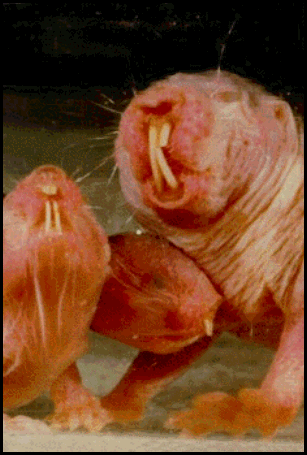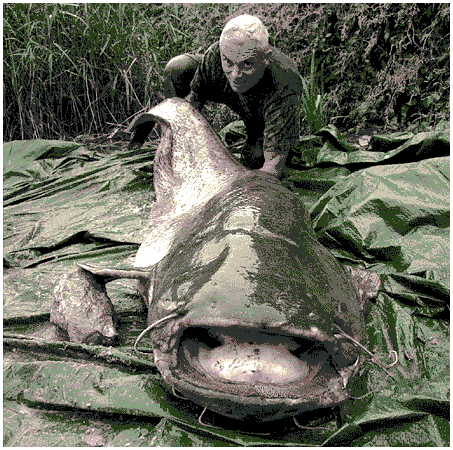Of the World's
Strangest Animals
Paula Hammond
(Marshall Cavendish Reference)

Add to that the fact that the lady of the nest achieves dominance over all her competitors by pissing on them. And as if there weren't enough of these rat-like creatures to suit us for a lifetime or two, the author tells us that the female can litter four times a year and the little tykes look even more homely than she does.
This unpleasant beast is but one of fifty "Strange Animals" that Dr. Hammond has dug up to amaze (or disgust) us. But some of these creatures are not all that beastly. I don't have to take to my heels when I am looking at, for instance, the Skylark, the Bottlenose Dolphin, the Red Kangaroo ... or even the American Bullfrog (with whom I grew up).
I might have more trouble with the Tamarin of Ecuador who looks not unlike Dr. Fu Manchu ... or the Southern Tamandua of Brazil who doesn't walk, we are told, but waddles like my Aunt Beulah; or, gack, the Wels Catfish of Eastern Europe, equipped with four "barbels" ... not for improving the physique but for seeking out lunch: little whiskers heavy with taste buds, the better to find delicious bits of trash in the murky waters they favor. These fish also sink to the bottom and rise to the bait with the help of a little gas-bladder which I wouldn't mind having one myself if it would help me to get around in the ocean.
Hammond calls these fish strange, but they lack something that made the catfish of my childhood much more formidable: a fin that emerges from the upper back whenever you caught them ... and then tried to unhook the little bastards. They would swallow your fishing line as far down as possible in the gullet and when you tried to disengage them from your expensive tackle, they would "fin" you: the sticker being jampacked with a noxious venom giving them the last laugh (and indeed, their ugly little pusses look like they are laughing ... or at worst, retching at you).
Our local dish of choice, catfish stew, was nothing to write home about either.

When we ran across the Duck-Billed Platypus on page 66, we could agree with Hammond that he's a weird one, finding to our surprise that this creature, which we always suspected of being secretly friendly, was "one of the world's few venomous mammals:" he (or she) is able to inject you with a poison by means of a spur in the back paw. Unfortunately for them (and fortunately for you), they are restricted to your neighborhood zoo and to Australia, a place described by one historian as "a nation of small shoplifters" (the original non-natives were convicts shipped out from England in the 19th Century).
Whenever some of us think on the platypus --- which I often don't --- we can't help but remember the Tom Lehrer song about Oedipus Rex, which ends,
-
So be sweet and kind to mother,
Now and then have a chat.
Buy her candy or some flowers or a brand new hat.
But maybe you had better let it go at that!
Or you may find yourself with a quite complex complex,
And you may end up like Oedipus.
I'd rather marry a duck-billed platypus,
Than end up like old Oedipus rex.
Another musical item we found here had to do with the common Cuckoo who reminds me of cousins who move in with us in the summer and stay around long enough to eat everything that isn't nailed down and often bring along other cousins we've never heard of and would have preferred not to know.
Like them, the Cuckoo leaves her progeny around in any handy nest and when the sprats hatch, they kick their stepbrothers and sisters out onto the ground below where they perish. The intruder then starts to gorge on the worms and thrips and other delicacies brought home by their parents whomay be mystified (like many of us parents are) that we could have sired such an unkempt and noisy beast.
But we will forgive the common Cuckoo his bad habits because of a traditional song imbedded in our hearts by an old-timey singer out of the hills of North Carolina who cared little or not at all about their anti-social nesting habits:
-
Oh, the cuckoo, she's a pretty bird,
Lord, she warbles as she flies;
She'll never say cuckoo
Till the fourth day of July.
She sucks all the sweet flowers
To make her voice so clear
She never sings cuckoo
Till the summer-time is near.
Oh, she flies the hills over
She flies the world above
She flies back to the mountain
A-mourning for her love.
Oh the cuckoo she's a pretty bird
She warbles as she flies
She brings us glad tidings
And tells us no lies.
